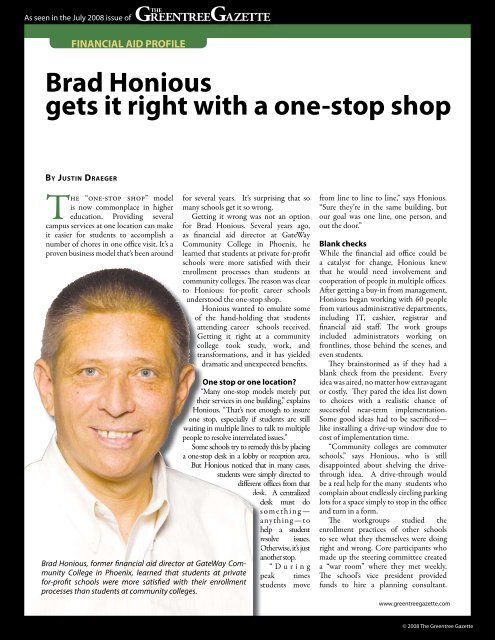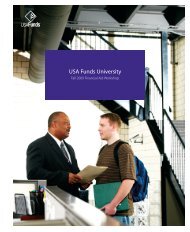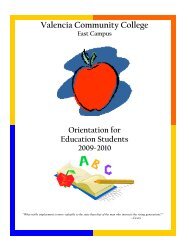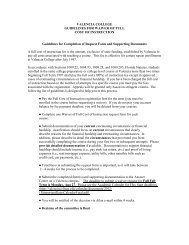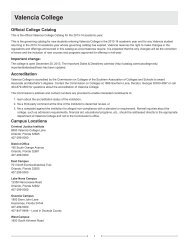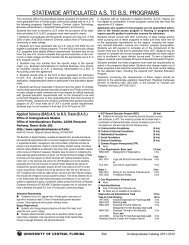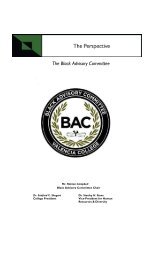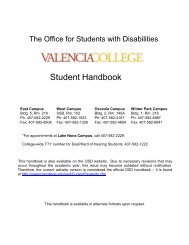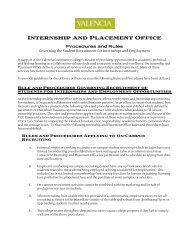Brad Honious gets it right with a one-stop shop - Valencia College
Brad Honious gets it right with a one-stop shop - Valencia College
Brad Honious gets it right with a one-stop shop - Valencia College
Create successful ePaper yourself
Turn your PDF publications into a flip-book with our unique Google optimized e-Paper software.
As seen in the July 2008 issue of<br />
FINANCIAL AID PROFILE<br />
<strong>Brad</strong> <strong>Honious</strong><br />
<strong>gets</strong> <strong>it</strong> <strong>right</strong> w<strong>it</strong>h a <strong>one</strong>-<strong>stop</strong> <strong>shop</strong><br />
BY JUSTIN DRAEGER<br />
The “<strong>one</strong>-<strong>stop</strong> <strong>shop</strong>” model<br />
is now commonplace in higher<br />
education. Providing several<br />
campus services at <strong>one</strong> location can make<br />
<strong>it</strong> easier for students to accomplish a<br />
number of chores in <strong>one</strong> office vis<strong>it</strong>. It’s a<br />
proven business model that’s been around<br />
for several years. It’s surprising that so<br />
many schools get <strong>it</strong> so wrong.<br />
Getting <strong>it</strong> wrong was not an option<br />
for <strong>Brad</strong> <strong>Honious</strong>. Several years ago,<br />
as financial aid director at GateWay<br />
Commun<strong>it</strong>y <strong>College</strong> in Phoenix, he<br />
learned that students at private for-prof<strong>it</strong><br />
schools were more satisfied w<strong>it</strong>h their<br />
enrollment processes than students at<br />
commun<strong>it</strong>y colleges. The reason was clear<br />
to <strong>Honious</strong>: for-prof<strong>it</strong> career schools<br />
understood the <strong>one</strong>-<strong>stop</strong> <strong>shop</strong>.<br />
<strong>Honious</strong> wanted to emulate some<br />
of the hand-holding that students<br />
attending career<br />
schools received.<br />
Getting <strong>it</strong> <strong>right</strong> at a commun<strong>it</strong>y<br />
college took study, work, and<br />
transformations, and <strong>it</strong> has yielded<br />
dramatic and unexpected benef<strong>it</strong>s.<br />
One <strong>stop</strong> or <strong>one</strong> location?<br />
“Many <strong>one</strong>-<strong>stop</strong> models merely put<br />
their services in <strong>one</strong> building,” explains<br />
<strong>Honious</strong>. “That’s not enough to insure<br />
<strong>one</strong> <strong>stop</strong>, especially if students are still<br />
wa<strong>it</strong>ing in multiple lines to talk to multiple<br />
people to resolve interrelated issues.”<br />
Some schools try to remedy this by placing<br />
a <strong>one</strong>-<strong>stop</strong> desk in a lobby or reception area.<br />
But <strong>Honious</strong> noticed that in many cases,<br />
students were simply directed to<br />
different offices from that<br />
desk. A centralized<br />
desk must do<br />
something—<br />
anything—to<br />
help a student<br />
resolve<br />
issues.<br />
Otherwise, <strong>it</strong>’s just<br />
another <strong>stop</strong>.<br />
<strong>Brad</strong> <strong>Honious</strong>, former financial aid director at GateWay Commun<strong>it</strong>y<br />
<strong>College</strong> in Phoenix, learned that students at private peak<br />
times<br />
for-prof<strong>it</strong> schools were more satisfied w<strong>it</strong>h their enrollment students<br />
move<br />
processes than students at commun<strong>it</strong>y<br />
“During<br />
colleges.<br />
from line to line to line,” says <strong>Honious</strong>.<br />
“Sure they’re in the same building, but<br />
our goal was <strong>one</strong> line, <strong>one</strong> person, and<br />
out the door.”<br />
Blank checks<br />
While the financial aid office could be<br />
a catalyst for change, <strong>Honious</strong> knew<br />
that he would need involvement and<br />
cooperation of people in multiple offices.<br />
After getting a buy-in from management,<br />
<strong>Honious</strong> began working w<strong>it</strong>h 60 people<br />
from various administrative departments,<br />
including IT, cashier, registrar and<br />
financial aid staff. The work groups<br />
included administrators working on<br />
frontlines, those behind the scenes, and<br />
even students.<br />
They brainstormed as if they had a<br />
blank check from the president. Every<br />
idea was aired, no matter how extravagant<br />
or costly. They pared the idea list down<br />
to choices w<strong>it</strong>h a realistic chance of<br />
successful near-term implementation.<br />
Some good ideas had to be sacrificed—<br />
like installing a drive-up window due to<br />
cost of implementation time.<br />
“Commun<strong>it</strong>y colleges are commuter<br />
schools,” says <strong>Honious</strong>, who is still<br />
disappointed about shelving the drivethrough<br />
idea. A drive-through would<br />
be a real help for the many students who<br />
complain about endlessly circling parking<br />
lots for a space simply to <strong>stop</strong> in the office<br />
and turn in a form.<br />
The workgroups studied the<br />
enrollment practices of other schools<br />
to see what they themselves were doing<br />
<strong>right</strong> and wrong. Core participants who<br />
made up the steering comm<strong>it</strong>tee created<br />
a “war room” where they met weekly.<br />
The school’s vice president provided<br />
funds to hire a planning consultant.<br />
70 THE GREENTREE GAZETTE July 2008<br />
www.greentreegazette.com<br />
0807DraegerFinancialAidProfile.indd 70<br />
© 2008 The Greentree Gazette<br />
6/23/2008 5:33:47 PM
As seen in the July 2008 issue of<br />
They also hired add<strong>it</strong>ional staff to fill in<br />
for individuals who were involved in the<br />
implementation.<br />
After nearly two years of study<br />
and preparation, “GateWay Central”<br />
emerged. It goes even further than the<br />
<strong>one</strong>-<strong>stop</strong> <strong>shop</strong> model. The <strong>one</strong>-<strong>stop</strong> study<br />
launched a larger amb<strong>it</strong>ion: to build<br />
better relationships w<strong>it</strong>h students and<br />
retain them so they successfully finish<br />
school.<br />
GateWay Central would establish <strong>one</strong><br />
counter where students are adm<strong>it</strong>ted,<br />
register for classes, complete financial<br />
aid forms, and pick up ID cards and<br />
parking perm<strong>it</strong>s. Along w<strong>it</strong>h that, the<br />
steering comm<strong>it</strong>tee revamped several<br />
management and financial aid policies.<br />
The steering comm<strong>it</strong>tee tapped a local<br />
professor and consultant to learn about<br />
“kaizen,” a management style used by<br />
companies like Toyota that focuses on an<br />
entire process, not just the present view.<br />
GateWay’s goal was to use kaizen to help<br />
students succeed.<br />
Teams and more teams<br />
Staff were cross-trained. Managers who<br />
formerly supervised <strong>one</strong> function needed<br />
skills to oversee multiple administrative<br />
areas. The management structure became<br />
lighter and more agile. The steering<br />
comm<strong>it</strong>tee formed add<strong>it</strong>ional workgroups<br />
to restructure the organization chart. “We<br />
had a steering team. We had a <strong>one</strong>-<strong>stop</strong> team<br />
to review front counter operations. We had<br />
a training team, and a technology team and<br />
a construction team,” says <strong>Honious</strong>.<br />
During the rollout <strong>it</strong> became evident<br />
that they had to remove other student<br />
logjams. Like many commun<strong>it</strong>y colleges,<br />
Gateway had an undesirable student loan<br />
default rate—as high as 19 percent in<br />
recent years. The financial aid office had<br />
been wary of packaging students w<strong>it</strong>h<br />
federal loans upfront, but this didn’t f<strong>it</strong><br />
their new philosophy. W<strong>it</strong>hout having<br />
student loans packaged upfront, GateWay<br />
students often used cred<strong>it</strong> cards to pay<br />
for living expenses and tu<strong>it</strong>ion. In a bold<br />
move, <strong>Honious</strong> began offering financial<br />
aid awards w<strong>it</strong>h student loans.<br />
“Some of my colleagues thought I was<br />
nuts!” he exclaims. “But I believed that<br />
we had to give students these options to<br />
help them work fewer hours, enroll for<br />
more cred<strong>it</strong> hours and complete their<br />
schooling quicker.”<br />
They implemented m<strong>one</strong>y management<br />
and financial aid courses that qualified for<br />
college cred<strong>it</strong>. They implemented a m<strong>one</strong>y<br />
management webpage. These moves were<br />
some of their “in-reach” efforts. While<br />
outreach attempts to bring students into the<br />
school, in-reach tries to retain the students you<br />
have and help them complete their program.<br />
GateWay began offering counseling, financial<br />
l<strong>it</strong>eracy courses, life skills courses, and they<br />
communicated more often w<strong>it</strong>h them. The<br />
core competencies of the cred<strong>it</strong> courses were<br />
approved by the Maricopa Commun<strong>it</strong>y<br />
<strong>College</strong>s’ Curriculum Comm<strong>it</strong>tee and<br />
were built around USA Funds Life Skills,<br />
a financial-l<strong>it</strong>eracy curriculum that gives<br />
schools tools to teach students m<strong>one</strong>y and<br />
time management skills.<br />
The results<br />
After two years of planning and two years<br />
of implementation, GateWay Central<br />
became a fully functioning <strong>one</strong>-<strong>stop</strong> <strong>shop</strong><br />
for students.<br />
&<br />
SCHOLARS<br />
DOLLARS<br />
“You should see the faces on students<br />
when they realize they can get all the<br />
service they need from <strong>one</strong> person,” says<br />
<strong>Honious</strong>. In cases where they need to meet<br />
w<strong>it</strong>h some<strong>one</strong> behind the scenes, a frontline<br />
staffer uses an in-house queue system<br />
that uses Microsoft Office SharePoint.<br />
Before long, an administrator joins the<br />
student for add<strong>it</strong>ional help.<br />
The results have been dramatic. Over<br />
five years, the number of students who<br />
completed their associate degrees nearly<br />
doubled from 800 to 1,500. The total<br />
number of students enrolled remained<br />
the same, but full-time enrollment<br />
increased, along w<strong>it</strong>h students’ likelihood<br />
of graduation.<br />
Offering federal student loans upfront<br />
also had pos<strong>it</strong>ive effects. While annual<br />
federal loan volume increased from<br />
$700,000 to $8 million w<strong>it</strong>hin three years,<br />
the cohort default rate decreased from<br />
9 percent to 5.4 percent. The number of<br />
students using cred<strong>it</strong> cards to pay tu<strong>it</strong>ion<br />
decreased dramatically from 2,300 to<br />
about 200. The increased financial aid<br />
also helped students dedicate more time<br />
to school, and their average increased<br />
from 8.2 cred<strong>it</strong> hours per semester to 9.5<br />
cred<strong>it</strong> hours.<br />
<strong>Honious</strong> has since left GateWay to a<br />
job as system-wide director of financial<br />
aid w<strong>it</strong>h <strong>Valencia</strong> Commun<strong>it</strong>y <strong>College</strong><br />
in Orlando, Florida. <strong>Valencia</strong> was <strong>one</strong> of<br />
the schools GateWay used as a model for<br />
<strong>it</strong>s <strong>one</strong>-<strong>stop</strong> <strong>shop</strong>. <strong>Honious</strong> looks back at<br />
his achievements at GateWay w<strong>it</strong>h great<br />
pride. “We increased access and success,”<br />
he says, two small words that sum up the<br />
gold standard of all higher education<br />
professionals. <br />
RENEW YOUR SUBSCRIPTION TODAY!<br />
THE GREENTREE GAZETTE<br />
<br />
JULY 2008<br />
JULY 2008<br />
GREENTREEGAZETTE<br />
GTHE<br />
T H E B U S I N E S S M A G A Z I N E F O R H I G H E R E D U C A T I O N<br />
Sustainable,<br />
Eco-Friendly<br />
and U.<br />
The Greentree Gazette is free to<br />
financial aid administrators!<br />
Renew your subscription today at<br />
www.greentreegazette.com/july<br />
www.greentreegazette.com July 2008 THE GREENTREE GAZETTE 71<br />
0807DraegerFinancialAidProfile.indd 71<br />
© 2008 The Greentree Gazette<br />
6/23/2008 5:34:18 PM


